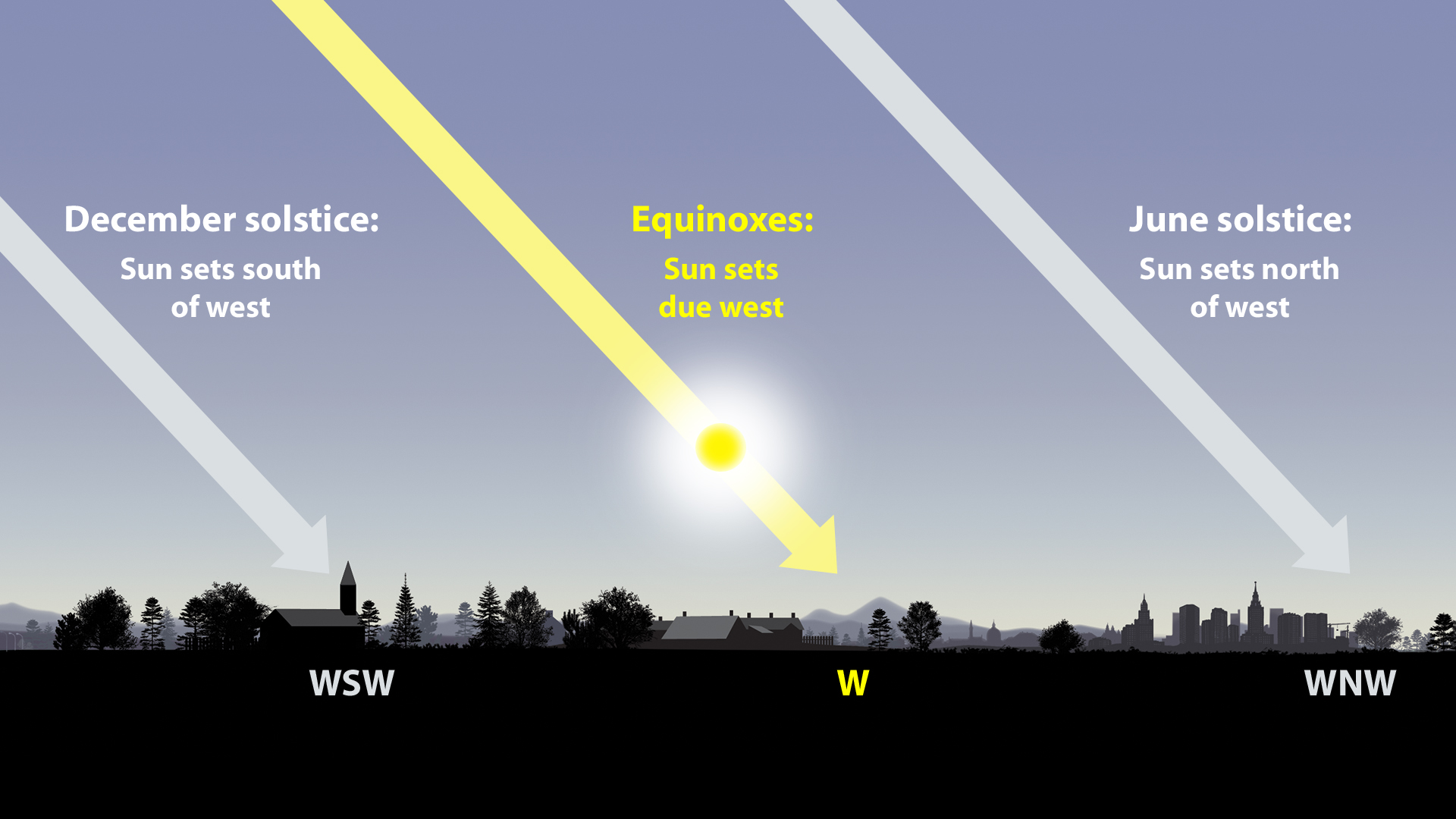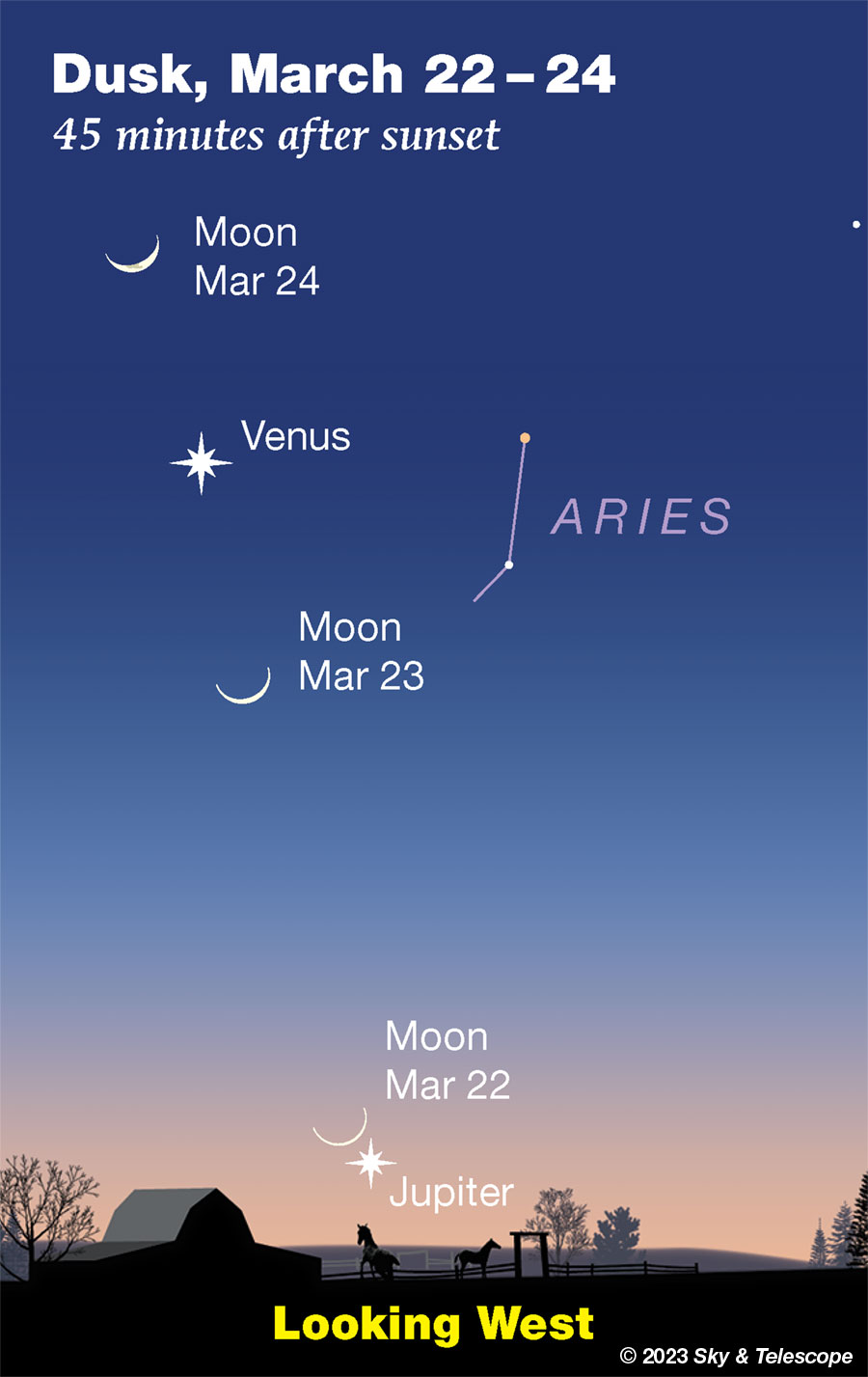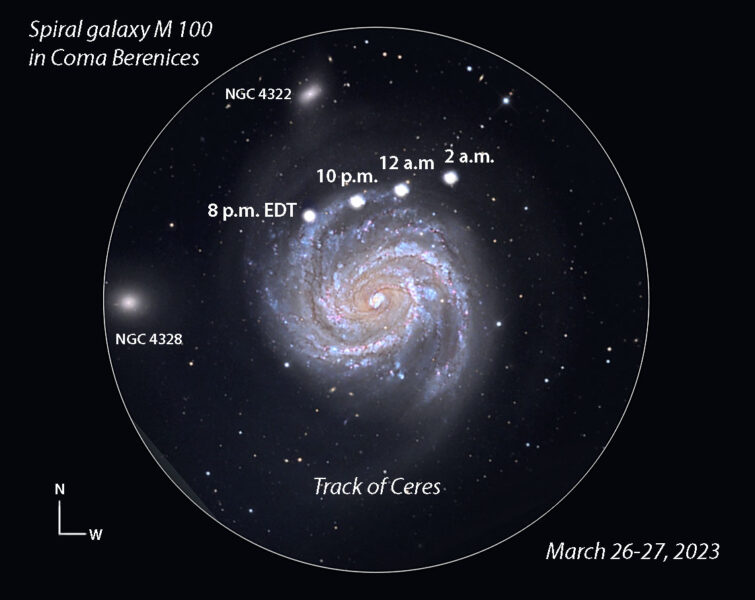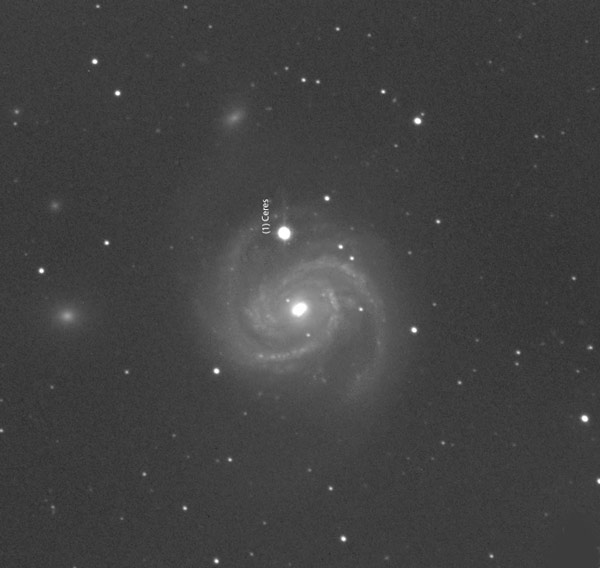FRIDAY, MARCH 17
■ Spring arrives this week (the equinox is on March 20th), so Orion stands upright high in the south-southwest as the stars come out. He's just starting his long spring tilt and departure down toward the west — as the hours pass in the evening, and as the weeks pass with the advancing season.
■ By nightfall this week, the Big Dipper is high in the northeast and beginning to tip left. Look left of its center, by about three fists at arm's length, for Polaris in the dim Little Dipper. Other than Polaris, all you may see of the Little Dipper through light pollution are the two stars forming the outer edge of its bowl: Kochab (similar to Polaris in brightness) and below it, fainter Pherkad. Find these two "Guardians of the Pole" to Polaris's lower right by about a fist and a half at arm's length. They're 2nd and 3rd magnitude.
Now is the time of year when the Guardians line up exactly vertically around the end of twilight.
SATURDAY, MARCH 18
■ On the traditional divide between the "winter" and "spring" sky is the dim constellation Cancer, now very high toward the south. It's between Gemini to its west and Leo to its east.
Cancer holds something unique: the Beehive Star Cluster, M44, in its middle. The Beehive shows dimly to the naked eye if you have little or no light pollution. With binoculars it's easy even under mediocre conditions. Look for it a little less than halfway from Pollux in Gemini to Regulus in Leo. And see Fred Schaaf's "Sighting the Beehive" in the March Sky & Telescope, page 45.
SUNDAY, MARCH 19
■ The "twin" heads of the Gemini figures are fraternal twins at best. Pollux is visibly brighter than Castor and pale orange. And as for their physical nature, they're not even the same species.
Pollux is a single orange giant. Castor is a binary pair of two smaller, hotter, white main-sequence stars, a fine double in amateur telescopes. If Pollux were a basketball, white Castor A and B would be a brilliant tennis ball and baseball about a half mile apart.
Moreover, each Castor star is closely orbited by an unseen red dwarf — dim marbles in our scale model, only a foot or so from the tennis ball and the baseball.
And a very distant tight pair of red dwarfs, Castor C, is visible in amateur scopes as a single, 10th-magnitude speck 70 arcseconds south-southeast of the main pair. In our scale model, they would be a pair of marbles only about 3 inches apart at least 10 miles from Castor A and B.
Double stars come in a vast range of true separations — from nearly a light-year apart down to actually touching.
MONDAY, MARCH 20
■ Spring begins today (in the Northern Hemisphere) at 5:24 p.m. EDT (21:24 UT). That's the moment of the equinox, when the center of the Sun crosses the equator (both Earth's equator and the celestial equator) heading north for the warm months.
The equinox is when the Sun is up for 12 hours (very nearly) and down for 12 hours (very nearly). It's also when the Sun rises and sets due east and due west (very nearly).

Okay, why "very nearly"? If you've ever looked up your sunrise and sunset times on the equinox day, you've seen that they are not 12 hours apart. Because...
1) Atmospheric refraction at the horizon bends the apparent position of the Sun up by about half a degree. This slightly advances the time of sunrise and delays sunset, and thus also shifts the places where these happen on the horizon slightly north.
2) Astronomers consider the Sun's position to be the position of the Sun's center, but "sunrise" and "sunset" mean the visibility of the Sun's top edge, which is ¼° higher. This adds slightly to the time shifts and north shifts.
TUESDAY, MARCH 21
■ The first-discovered asteroid, 1 Ceres, is at opposition in Coma Berenices. It glimmers at a binocular-friendly magnitude 6.9, and it's nice and high by late evening. See the article and finder charts in the March Sky & Telescope, page 48.
And on the night of March 26-27, Ceres crosses the face of the 10th-magnitude spiral galaxy M100. See March 26 below.
■ New Moon (exact at 1:23 p.m. EDT).
WEDNESDAY, MARCH 22
■ Look very low in the west in twilight for the thin crescent Moon paired with departing Jupiter, as shown below. Binoculars help.

THURSDAY, MARCH 23
■ The Moon shines below Venus this evening, as shown above.
■ After dark, Sirius sparkles brightly in the south-southwest. Lower left of Sirius, by about one fist, is the triangle of Adhara, Wezen, and Aludra, from right to left. They form Canis Major's hind foot, rear end, and tail, respectively. Or, alternatively, the lower end and handle of the Meat Cleaver.
Just left or upper left of them, forming a 3rd- and 4th-magnitude arc, are the three uppermost stars of the constellation Puppis. No, it's not a puppy, despite following right behind the Big Dog. It's the Poop Deck (stern) of the giant ancient constellation Argo Navis, the ship of Jason and the Argonauts. These three are the only stars of Argo you can see fairly easily from mid-northern latitudes.
Just 1.5° upper right of the middle of the three, binoculars on a dark night will show the 6th-magnitude open cluster M93. It's elongated northeast-southwest.
FRIDAY, MARCH 24
■ Now the thickening crescent Moon shines above Venus during and after twilight.
■ The Big Dipper glitters softly high in the northeast these evenings, standing on its handle. You probably know that the two stars forming the front of the Dipper's bowl (currently on top) are the Pointers; they point to Polaris, currently to their left or lower left.
And, you may know that if you follow the curve of the Dipper's handle out and around by a little more than a Dipper length, you'll arc to Arcturus, now rising in the east.
But did you know that if you follow the Pointers backward the opposite way, you'll land in Leo?
Draw a line diagonally across the Dipper's bowl from where the handle is attached, continue far on, and you'll go to Gemini.
And look at the two stars forming the open top of the Dipper's bowl. Follow this line past the bowl's lip far across the sky, and you crash into Capella.
SATURDAY, MARCH 25
■ Higher above Venus now, the waxing crescent Moon shines just a couple degrees from the Pleiades.
■ The signature fall-and-winter constellation Cassiopeia retreats down after dark. Look for it fairly low in the north-northwest. It's standing roughly on end.
But for skywatchers at mid-northern latitudes Cassiopeia is circumpolar, never going away completely. By 1 or 2 a.m. daylight-saving time it's at its lowest due north, lying not quite horizontally.
SUNDAY, MARCH 26
This evening Ceres, 7th magnitude, crosses the northernmost spiral arm of the 10th-magnitude galaxy M100 in Coma Berenices, as shown below. Unlike how galaxies look in images, their dense inner regions are generally much more visible in telescopes than their low-surface-brightness disc and arms.


This Week's Planet Roundup
Mercury is hidden in the glow of sunset. But it's heading up for a good evening apparition in early April.
Venus (magnitude –4.0, in Aries) is the "Evening Star" shining brightly in the west during and after dusk. It finally sets about 2 hours after dark. Telescopically, Venus is a shimmering little gibbous ball 13 arcseconds in diameter and 82% sunlit.
Mars crosses from the horns of Taurus toward the feet of Gemini this week, moving east against the stars. Look for it high in the southwest in early evening, lower in the west later. It's upper left of Venus by about five fists at arm's length.
Mars continues to fade: from magnitude +0.7 to +0.8 this week. It's very similar to Mars-colored Aldebaran (+0.9) some 18° below it, and Mars-colored Betelgeuse (currently +0.4) about the same distance to Mars's lower left. They form a big, temporary Orange Triangle, equilateral or nearly so.
In a telescope Mars is now a little blob only 7 arcseconds wide, generally too small to show any detail visually. But notice its gibbous shape: 90% sunlit.
Jupiter is heading down deep into the afterglow of sunset. Look for it about two fists lower right of Venus. Binoculars may help, especially later in the week.
Saturn is deep in the dawn glow, very low in the east-southeast. Try binoculars about 40 minutes before sunrise.
Uranus, magnitude 5.8 in Aries, is in the west right after dark above Venus. Uranus finder charts are in last November's Sky & Telescope, page 49.
Neptune is hidden low in the sunrise.
All descriptions that relate to your horizon — including the words up, down, right, and left — are written for the world's mid-northern latitudes. Descriptions and graphics that also depend on longitude (mainly Moon positions) are for North America.
Eastern Daylight Time (EDT) is Universal Time minus 4 hours. UT is sometimes called UTC, GMT, or Z time.
Want to become a better astronomer? Learn your way around the constellations. They're the key to locating everything fainter and deeper to hunt with binoculars or a telescope.
This is an outdoor nature hobby. For a more detailed constellation guide covering the whole evening sky, use the big monthly map in the center of each issue of Sky & Telescope, the essential magazine of astronomy.
Once you get a telescope, to put it to good use you'll need a much more detailed, large-scale sky atlas (set of charts). The basic standard is the Pocket Sky Atlas (in either the original or Jumbo Edition), which shows all stars to magnitude 7.6.

Next up is the larger and deeper Sky Atlas 2000.0, plotting stars to magnitude 8.5; nearly three times as many. The next up, once you know your way around, are the even larger Interstellarum atlas (stars to magnitude 9.5) or Uranometria 2000.0 (stars to magnitude 9.75). And be sure to read How to Use a Star Chart with a Telescope. It applies just as much to charts on your phone or tablet as to charts on paper.
You'll also want a good deep-sky guidebook. A beloved old classic is the three-volume Burnham's Celestial Handbook. An impressive more modern one is the big Night Sky Observer's Guide set (2+ volumes) by Kepple and Sanner.
Can a computerized telescope replace charts? Not for beginners, I don't think, and not on mounts and tripods that are less than top-quality mechanically. And as Terence Dickinson and Alan Dyer say in their Backyard Astronomer's Guide, "A full appreciation of the universe cannot come without developing the skills to find things in the sky and understanding how the sky works. This knowledge comes only by spending time under the stars with star maps in hand."
![]() Audio sky tour. Out under the evening sky with your
Audio sky tour. Out under the evening sky with your
earbuds in place, listen to Kelly Beatty's monthly
podcast tour of the heavens above. It's free.
"The dangers of not thinking clearly are much greater now than ever before. It's not that there's something new in our way of thinking, it's that credulous and confused thinking can be much more lethal in ways it was never before."
— Carl Sagan, 1996
"Facts are stubborn things."
— John Adams, 1770
Editorial note (March 22, 2023): This post has been corrected to reflect that the spring equinox occurred on March 21st at 21:24 Universal Time.
 12
12









Comments
mary beth
March 17, 2023 at 11:08 pm
The other astronomy and time and date websites I’ve been on show the equinox occurring at 21:24 UTC not 21:42 as shown here. Can someone please verify which one is correct?
You must be logged in to post a comment.
Anthony Barreiro
March 18, 2023 at 8:26 pm
Good catch, Mary Beth. My references also say the equinox will be at 2124 UTC.
https://www.weather.gov/media/ind/seasons.pdf concurs:
Earth Seasons - Equinoxes and Solstices - 2022-2026
from the U.S. Naval Observatory, Astronomical Applications Department
...2023...
VERNAL EQUINOX.....(SPRING) MAR 20 2023 524 PM EDT - 2124 UTC
You must be logged in to post a comment.
mary beth
March 19, 2023 at 12:24 am
Thank you Anthony. I usually have a little celebration with my neighbor welcoming the season. Would not want to be tardy lol.
You must be logged in to post a comment.
Rod
March 18, 2023 at 9:18 pm
"Spring begins today (in the Northern Hemisphere) at 5:42 p.m. EDT (21:42 UT)."
This does look off. The Skygazer's Almanac 2023 from Sky & Telescope shows 20-Mar-2023 at 5:24 PM EDT or 2124 UT. The March issue of Sky & Telescope on page 41 shows the same, 5:24 PM EDT.
You must be logged in to post a comment.
Rod
March 18, 2023 at 9:20 pm
5:42 looks like a transpose number, 5:24 is correct sequence. 🙂
You must be logged in to post a comment.
mary beth
March 19, 2023 at 12:26 am
Easy to make that mistake. And difference always divisible by 9.
You must be logged in to post a comment.
Rod
March 20, 2023 at 9:50 pm
I did enjoy some spring stargazing tonight.
Observed 2000-2100 EDT. Spring Equinox 20-March-2023 at 1724 EDT/2124 UT. New Moon 21-March-2023 1723 UT. I used my 90-mm refractor telescope for some evening stargazing. Targets viewed M44, M67 in Cancer, M35, NGC 2158 in Gemini, and M42 in Orion. Magnification 25x to 71x observations. M67 looked good, better in my 10-inch Newtonian. M35 and NGC 2158 visible too in the FOV. Mars in Taurus about 4.5-degrees angular separation from M35 in Gemini according to Stellarium 1.2. A relaxing time of open cluster and M42 nebula viewing. Wood burning stove running earlier. Temperature -5C this morning and last couple of nights. Spring is here today but some late winter temperatures continue to hang around 🙂 Tonight 2C while observing.
You must be logged in to post a comment.
mary beth
March 21, 2023 at 2:01 pm
Brrrrrrr! At the end of the month, according to folklore, the “Borrowing Days”will be upon us:
March borrowit from April
Three days, and they were ill:
The first was frost, the second was snaw,
The third was cauld as ever't could blaw.
-- Scottish proverb
You must be logged in to post a comment.
cyrtonyx
March 21, 2023 at 7:10 pm
March actually goes out like a Salt Marsh Harvest Mouse.........
You must be logged in to post a comment.
B l a k s t a r
March 22, 2023 at 10:46 pm
March 22, 2023, this evening my wife and I saw a 1d old crescent moon for the first time. A very special one from Barbados as at this location Jupiter was occulted and emerged “attached” to the RS of the crescent visible only in our 8x42 binos. It was a spectacular sight watching the planet brighten, enlarge and separate from the crescent and disk. Soon we could observe the event naked eye with Venus above and the night sky deepening with the stars appearing. The bino views enhanced the experience tremendously, the full earthshine disk, crescent sunlit sliver and massive planet. We will never forget this night!
You must be logged in to post a comment.
misha17
March 22, 2023 at 11:24 pm
Blakstar: You are one of the lucky few who were able to see it. Because it occurred so close to the New Moon, most of the path of occultation passed over Pacific Ocean and all but the easternmost tip of South America where it was still daylight.
It only occurred in twilight or night skies over far eastern Brazil and the southern Caribbean islands, just before moonset.
Next month's occultation is not visible at all, as it occurs just a day before New Moon so it's hidden in daylight or strong morning or evening twilight. If ti were visible, the path would cross Central America and the Caribbean islands (again).
The May 17th occultation is the last in the series and ~might~ be visible along the West U.S. coast and possibly as far east as Texas, with Moon and Jupiter low in the pre-dawn sky.
Occultation maps here:
http://www.lunar-occultations.com/iota/planets/jupiter.png
right-click on the link to open in an new tab or window.
You must be logged in to post a comment.
B l a k s t a r
March 23, 2023 at 6:53 pm
misha17, “ You are one of the lucky few who were able to see it.” Yes! We were pondering that yesterday and today as well with the low cloud and ever changing sky arrangement. Very fortunate indeed!
You must be logged in to post a comment.
You must be logged in to post a comment.